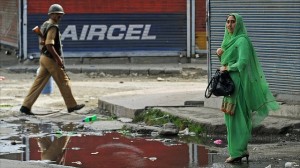Anna Davis is a junior from Prattville, Alabama who is majoring in Geography and Religious Studies. She wrote this post as part of Dr. Steven Ramey’s course, REL 321: Religion & Identity in South Asia
The geographic area of South Asia has experienced a catastrophic series of floods in recent weeks. The region of Kashmir in particular has had a difficult time recovering from the floods in part because of the aid that was provided. People died during the floods and are now dying from disease spread by the floods. Many Kashmiris still refuse Indian intervention and relief. Food bags were dropped to the people, but the people chose to dump the food onto the ground.
According to the New York Times, the Indian government focused their rescue efforts on saving leaders in the communities and ignored the Muslim families. Some members of the Kashmiri community are refusing Indian aid because they claim the motive behind India’s gesture is to curry favor from the leaders in the region and influence the citizens to identify as part of India out of gratitude for their aid. Perhaps Indian leaders think that providing for the people in dire need would render them indebted to India and thus more docile towards India and accepting of their rule. However, due to the high Muslim population in Kashmir and the high Hindu population in India, this happy unification as a community is unlikely. The distinction between Indians and Kashmiris is very defined within this article. According to the New York Times’ representation, the first is Hindu, and the latter is Muslim.
Benedict Anderson developed the idea of “imagined communities” to describe the organization of nation-states. Imagined communities are in short a group of people who identify themselves as being members of said group. As an Alabama fan, I would consider myself a part of the “Bama Nation.” This nation does not technically exist as a nation-state, but it is imagined like nation-states are imagined. There are common factors that reinforce the identity of the community, such as singing “Yea Alabama,” responding with “Roll Tide,” and wearing crimson.
Kashmir is in an identity crisis because this one area is being classified into two different identities or imagined communities. Most Indians would claim that Kashmir is part of India, but if the Kashmiri people reject that assertion, are they still members of that imagined community? This seems to be a situation where the application of Anderson’s model becomes complicated. Maybe Kashmir and India are not one imagined community, but two different communities. Or perhaps Kashmir is a member of two communities. To an Indian, their imagined community might include Kashmir. To a Kashmiri, the community may be only Kashmir or a part of Pakistan. Are all members of an imagined community allowed to decide whether or not they participate in the group?
I, like the Kashmiris have multiple identities. In addition to my membership in the Bama Nation, I am an American. I did not decide to be born in America, but just by being born here, I am a part of a community. I can break away from my community if I so wish, but initially it is not my choice. Similarly for Kashmir, originally grouped with India by the British and Indians during the Partition, Kashmir can deny its membership in the Indian community, and thus be free to join or create any community it desires. India does not have to accept Kashmir’s denial of the group identity, and there in lies the problem. The possibility of the multiplicity of identities becomes confusing and complex. I do not think we can place Kashmir into one group because it can be classified into multiple communities depending on whose perspective is being represented. Identification is the conglomeration of opinions from both the self and others, and is thus relative and difficult to define.
